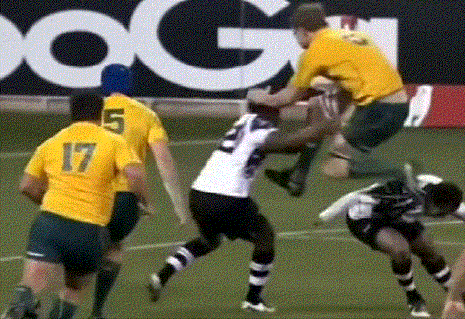It’s unusual to see experienced players jumping into a tackle in rugby, but it still happens. This article shows several examples, including one involving a legendary international player and captain.
You’ll see that some players were penalized and some weren’t. And you may be surprised to learn that the laws of rugby aren’t definitive about jumping into tackles.
Read on…
Are Players Allowed Jump Into A Tackle In Rugby?
No law in rugby says that you can’t jump into a tackle.
However, referees will usually decide that the ball carrier’s action has resulted in dangerous play.
If the player is judged to be reckless with their boots or knees, a penalty will be awarded to the defending team.
Before we get into an in-depth discussion, let’s describe what we’re talking about.
I want to be clear that this is different from “hurdling” or jumping to evade a low tackle from the side.
Jumping Into A Tackle In Rugby
Here is the scenario. The ball carrier is running straight towards one or more defenders.
The defender is facing the ball carrier head on i.e. not running from the side.
The defender prepares to make a head-on tackle by setting their feet with a slight crouch.
The player with the ball jumps into the air with a knee raised, and cannons into the defender.
An Olympic hurdler might jump over the defender, but two of our examples show big burly back row forwards. They were never going to clear the defenders.
This isn’t “jumping over” a tackle, this is jumping into the tackle.
A High-Profile Example Of Jumping Into A Tackle

The most high-profile example that I know comes from an international match between Australia and Fiji back in 2010. It’s not just that this was a test match.
The guy who jumps is none other than legendary back row Rocky Elsom, one of the most talented forwards I’ve ever seen from the stands.
Bone-crunching tackles, defense-busting runs, and delicate offloads – he had it all.
He joined Irish club Leinster in 2009 for a single season, but what a season!
Elsom simply dominated European club rugby through his contribution to the club’s first European Championship. Sadly, his body didn’t hold up against injuries for much longer.
But let’s go back to 2010 when Elsom busts out a new move in his repertoire.
The video evidence
The referee’s verdict – penalty!
The referee blew his whistle and awarded a penalty against Elsom. I don’t have sound in the video, so here’s exactly what the referee says.
“Jumped into the tackle, it’s dangerous play. Jumped into the tackle.”
transcript from the video
Elsom walks away like he isn’t impressed. And he’s got a legitimate right to wonder where jumping into the tackle is mentioned in the laws of rugby as being dangerous.
But before we tackle that question, let’s look at some more examples. Because not all referees will penalize this action.
The French Do It Their Way
Rocky Elsom’s leap took him chest height into the defenders.
But here’s an example from a French club match between Toulouse and Brive. The Toulouse flanker is a much lighter man than Elsom. He nearly clears the defenders.
Nearly but not quite! He still hits them with his feet.
It’s fair to say that the ball carrier is more likely to have done damage to himself with his heavy landing. The defenders certainly weren’t hurt in this incident.
The referee’s verdict – no penalty!
This may be going through the referee’s mind when he signals to play on. He judges there is no infringement committed.
You can almost hear him saying “Pff” as he gives a Gallic shrug of the shoulders.
It’s also fair to say that refereeing is slightly different in every country. I have no doubt that this action would be penalized as dangerous play in many other club competitions.
But don’t just take my word for it. Let’s look at one more example.
Everywhere Else Except France
Apologies for the video quality with this one, but It’s an older match from back in 2012. Two clubs are going at it in the English league: Gloucester and London Welsh.
The video evidence
Gloucester number 8, Sione Kalamafoni, is running the ball back from a kick. The big Tongan back row is full of focus and determination. He actually leaps well before contact with the tacklers and connects at the apex of his jump.
Once again, he’s nowhere close to hurdling over the tackle. He leads with a raised knee, which thankfully misses the head of the first tackler.
For good measure, he follows through with a raised elbow that hits the jugular of the second tackler. This guy will be getting pints in the club bar from his teammates!
The referee’s verdict
The referee is not impressed and awards a penalty against him. The sign language is pretty clear, but I’ll tell you exactly what the ref says.
“You can’t jump over the tackle. You run? No. You jumped.”
transcript from video
No Law In Rugby Union About Jumping Into Tackles

We have two examples where the referee says “you can’t jump into a tackle”. And one example where the verdict is “jouer” (play on).
How can there be such a difference? The reason is that there is no law in Rugby Union that says anything about jumping into tackles.
Of course, the two referees who penalize the action aren’t pretending to quote a non-existing law.
Instead, they are explaining what has led them to a decision under a very broad law: that of dangerous play.
Dangerous Play Covers Jumping Into Tackles
This is what the law book says about dangerous play:
“Players must not do anything that is reckless or dangerous to others.”
World Rugby Laws
Yes, it is very broad and therefore is quite vague. It means that it’s down to the referee’s interpretation.
The referee must believe that the ball carrier’s actions are dangerous to the safety of the defenders.
In practice, World Rugby issues detailed guidelines to all referees. And individual countries will also provide examples and explicit interpretations of dangerous play to their referees.
These may explicitly mention jumping into tackles.
In our French example, the ball carrier made minimal contact with the defenders.
I still think that other officials would have penalized the action. But there’s also a spirit in rugby of letting the game flow where possible.
Young Rugby Players Should Be Trained Not To Jump Into tackles
Jumping into tackles is almost an instinctive reaction when you are running straight towards an opponent who intends to bring you down.
So, the issue tends to crop up a lot in youth rugby with players being newly introduced to the sport. It’s not uncommon to see a youngster attempting a hop, skip, and jump into defenders.
We really don’t want their knee hitting the head or neck area of the opposing youngster who is braced to tackle.
A good referee will blow the whistle and explain clearly what’s wrong. “Don’t jump into the tackle” may be enough to get your message across. But don’t avoid a teachable moment.
In one of our examples, the referee used hand movements to a very large and fully grown man to explain that he can run into the tackle, but can’t jump into it.
Jumping Into Versus Over
Many referees will distinguish jumping into a head-on tackle versus hurdling a tackle from the side. They’ll penalize the former, but not the latter.
But the interpretation isn’t straightforward.
Check out our article that asks if you can jump over a tackle in rugby. We’ll show you a high-profile example where two top-class referees had very different opinions.